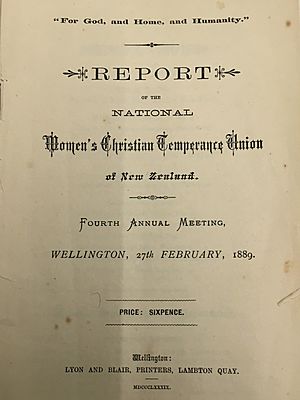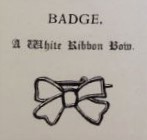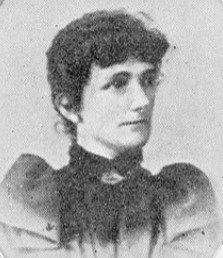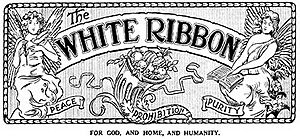Women's Christian Temperance Union New Zealand facts for kids
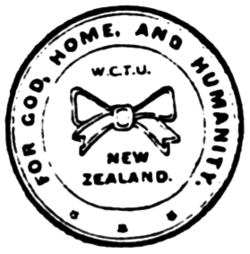 |
|
| Abbreviation | WCTU NZ |
|---|---|
| Founded | 1885 |
| Founded at | Wellington, New Zealand |
| Type | Umbrella organisation |
| Legal status | Charitable trust |
| Focus | temperance, protection of women and children |
|
President
|
Annette Paterson (2012–present) |
Women's Christian Temperance Union of New Zealand (WCTU NZ) is a non-partisan, non-denominational, and non-profit organisation that is the oldest continuously active national organisation of women in New Zealand. The national organisation began in 1885 during the visit to New Zealand by Mary Clement Leavitt, the first world missionary for the Woman's Christian Temperance Union. The WCTU NZ was an early branch of the World Woman's Christian Temperance Union and a founding affiliate of the National Council of Women of New Zealand. Men may join the WCTU NZ as honorary members.
Contents
Mission statement
To reduce health and social problems by promoting a lifestyle.
White ribbon badge
The official badge of the WCTU is a white ribbon: "a symbol of purity of purpose which binds together Christian women around the world." The white ribbon was first used by the American WCTU since its founding and in 1877 was officially featured in a bow. The white ribbon bow is worn pinned over the heart. During the union's early years in New Zealand, it would often be used together with the Gospel Temperance movement's blue ribbon.
Watchwords
The evangelistic work of all WCTU chapters is emphasized in the watchwords: Educate! Agitate! Legislate!
Noontide prayer
Members of the WCTU around the world were encouraged to spend an hour at noon every day for prayer and reflection. This served not only as a symbol of an international collective but also a tradition that could be conducted in one's own language and Christian religious doctrines. Many clubs used the popularity of the tune "Beautiful Isle of Somewhere," (written in 1897) to have trained vocalists sing "Beautiful Hour of Noontide":
- Somewhere the hands are lifted,/Somewhere the faith is strong./
- Somewhere the haze is lifted,/ God hears and sees the wrong./
- CHORUS: Noontide, noontide/Beautiful hour of noontide,/
- On land, or sea, we bow the knee,/Beautiful hour of noontide.
As New Zealand sees the first noontide hour of each day around the world, the WCTU NZ was particularly interested in supporting this effort.
- It is always noontide somewhere, / And across the awaking continents, / From shore to shore, somewhere, / Our prayers are rising evermore.
Organisational structure
The WCTU world missionary Mary Clement Leavitt brought with her the American version of the WCTU constitution which expressed the unique structure of this women's organisation through commonly identified departments. Many of the branches that flourished maintained this structure at the local level. For example, when Leavitt helped form the Auckland WCTU in February 1885, this club began first with five departments (temperance literature, heredity and hygiene, legislation, education, evangelistic and prison work) and later added more as the organisation matured.
As per the national WCTU constitution recorded and published as part of the report of the first national conference, the Departments of Work that local branches could choose from to establish were:
- Heredity
- Hygiene
- Scientific Instruction
- Sunday-School Work
- Juvenile Work
- Temperance Literature
- Influencing the Press
- Evangelistic Work
- Prisons and Police Stations
- Railroad Work
- Soldiers and Sailors
- Unfermented Wine
- Young Women's Work
- Drawing-room Meetings
- Kitchen Gardens
- Flower Missions
- Provincial and County Fairs
- Legislation and Petitions
- Work among Maoris
- Impure Literature
- Suppression of the Social Evil
Anne Ward, founding national president, made sure that at least some of this departmental infrastructure was in place at the national level and functioning across the various branches before she stepped down:
- Evangelistic Work; Legislation and Petitions (later also called Franchise); Social Purity; Hygiene; Influencing the Press; Unfermented Wine; Juvenile Work; Gaol Work; Young Women's Work; Work among Young Women.
These departments were described in full in WCTU literature such as National Woman's Christian Temperance Union Annual Leaflet (Chicago: Union Signal Print, 1885).
New Zealand and the World's WCTU
Mary C. Leavitt brought the World WCTU's Polyglot Petition for Home Protection to New Zealand. Undertaken by several of the earliest national presidents of the WCTU NZ, the Polyglot Petition gained 4,004 signatures from New Zealand. In June 1895, Kate Sheppard attended the World's WCTU conference in London, and it was there that she was encouraged to start the National Council of Women of New Zealand. Anderson Hughes-Drew, a New Zealander, served as an official round-the-world missionary for the World's WCTU. Margaret Jackson, WCTU NZ President, was elected president of the World WCTU in 2001 and served in that role until 2004.
National work undertaken in early years
Nascent WCTU chapters in New Zealand fought against laws inherited from England that supported and encouraged male-centred vices.
Scientific temperance instruction for children and youth
Since children were often sent to pubs to purchase alcohol for adults or were easily swayed to work in various parts of the liquor trade, the WCTU NZ early on worked to reform school curriculum and require scientific temperance instruction. In February 1887, the WCTU NZ national convention sent a formal resolution to the Minister for Education in which the Union sought for scientific temperance instruction be made compulsory in public school. Part of this campaign included the diseases associated with not only with alcohol but also the use of tobacco and the second-hand effects from those who smoke nearby. The WCTU NZ paid for literature to support school curriculum including textbooks, charts, songs and teaching lessons. In the early years, the WCTU NZ encouraged their local chapters to establish a "Cradle Roll" which included elaborate parties for children and encouraged their mothers to promise to teach their children about "total abstinence and purity." WCTU NZ collaborated with other local temperance groups to establish youth-led Loyal Temperance Legions which had their own officers.
Welfare work
Many communities were accustomed to and relied on collaborations among Christian churchwomen to provide emergency efforts or long-term resources for the needy. The WCTU NZ unions provided an organisational and scientific approach to what was already in hand by volunteers in local organisations such as the Ladies Christian Association or Ladies Committees of the Blue Ribbon Army. WCTU NZ unions organised hospitals, female refuges, sailors' rest homes, girls' hostels, orphanages, free kindergartens, infant care at big social events, non-alcoholic refreshment or tea rooms, youth homes or education centres for working children, "prison gate" half-way homes, and missionary outreach in Maori communities. Even after women gained the right to vote in national elections, the WCTU NZ continued to fight laws that kept women from their full rights as citizens, including running for elective office or co-guardianship of children. They supported the Prohibition League and No-License Council. They pushed for anti-gambling regulations and protested against State licensed lotteries which they saw as predatory especially on the working poor.
Petitions to New Zealand government for woman suffrage
The WCTU NZ petition campaigns for national woman suffrage were supported by directives from its founding chapters and the first convention in 1886.
- 1885 – deputation led by WCTU NZ Franchise Superintendent Mrs. G. Clark of Christchurch to petition Sir Julius Vogel to bring in a bill for woman suffrage; petitions signed by 18,537 to forbid women to serve in any capacity in public houses.
- 1886 – two petitions for women's suffrage, signed by 350 women, under the leadership of WCTU NZ president Anne Ward went to the House of Representatives.
- 1887 – an anti-barmaid petition organised in collaboration with the New Zealand Alliance for the Suppression and Prohibition of the Liquor Traffic with over 8,000 signatures; and a petition protesting the wording of the Electoral Bill that excluded women and reminding the Speaker of the woman suffrage bill passed in that same session - the petition was signed by the WCTU NZ president (Anne Ward), secretary (Susan Brett), treasurer (Mrs. C.A. Baker) and Superintendent of the Franchise Department (Mrs. G. Clark) accompanied by telegrams from six local Union presidents.
- 1888 – two petitions for woman suffrage from Emma E. Packe, WCTU NZ President with 780 signatures presented to the Legislative Council
- 1891 – eight petitions for woman suffrage with a total of 10,085 signatures, drive led by WCTU NZ president Catherine Fulton and national Franchise Superintendent Kate Sheppard, presented to the Lower House by Sir John Hall and Upper House by Hon. John Fulton who introduced a Female Suffrage Bill.
- 1892 – petitions for woman suffrage gathered by local Political Franchise Leagues (women's rights activist Anna Stout started the first of these in Dunedin) in partnership with WCTU NZ Franchise superintendents with 20,274 signatures to support Ballance's Electoral Bill.
- 1893 – Political Franchise Leagues and WCTU NZ local unions took about four months to gather thirteen petitions for woman suffrage which were signed by 31,872 women twenty-one years of age and over. More than 500 individual pages were glued together with wallpaper backing (but leaving out 12 other petitions with approximately 1500 names). This dramatic version of the petitions - a single roll measuring 270 metres - was wheeled into Parliament in a barrow where the roll was unfurled by Sir John Hall who claimed with was the largest petition ever presented to any Parliament in Australasia.
The White Ribbon (journal)
Local newspapers and contemporary temperance journals (such as the Temperance Herald and The Prohibitionist) carried articles about the WCTU abroad and in New Zealand. Also, local chapters would supply content for regular columns such as "Temperance Notes" in local papers, e.g., Wanganui Chronicle, and New Zealand Herald. In May 1895 the WCTU began publishing its own journal, The White Ribbon. Sheppard was the first editor, followed by Lucy Lovell-Smith (1903–1908). The longest serving editor was Nellie Peryman (1913–1945). In 1965 The White Ribbon became The New Zealand White Ribbon Digest, and then ceased publication in 2011. Now called the White Ribbon Bulletin, the official WCTU NZ publication is in newsletter format and, as with its predecessors, archived in the National Library of New Zealand.
Founding leadership
By the time of the first national convention held in Wellington 23–24 February 1886, there were fifteen local unions organised along the same WCTU constitution.
Founding Unions Organized by Mary C. Leavitt (and local presidents)
- 6 August 1884 (re-formed on 22 June 1885), Invercargill: Eliza Ann Palmer Brown (then Roberta Annie Swayne Hinton)
- 4 February 1885, Auckland: Ann Parkes Brame
- 5 May 1885, Dunedin: Catherine Fulton
- 5 May 1885, Port Chalmers: Mary Ann Roebuck Monson
- 15 May 1885, Christchurch: Emma Eliza De Winton Packe
- 28 May 1885, Rangiora: Grace Roberts Rowse (also president of Petone WCTU chapter after 1901)
- 11 June 1885, Napier: Mrs. T. G. Paterson
- 16 June 1885, Oamaru: Agnes Hunter Train Todd
Founding Unions Organized by Anne Ward
- 3 September 1885 – Wellington
- 16 September 1885 – Nelson
- 5 October 1885 – Wanganui
- 27 October 1885 – New Plymouth
- 29 October 1885 – Hawera
- 31 October 1885 – Patea
- January 1886 – Ashburton
Unions Formed 1887 - 1895
- 1887 - Roslyn
- 1888 - West Taieri (Outram), Lyttelton
- 1889 - Timaru (Mosgiel, North East Valley)
- 1891 - Palmerston
- 1892 - Kaiapoi, Fielding, Marton, Blenheim, West Coast (Hokitika)
- 1893 - Levin
- 1894 - Hastings
WCTU NZ National Presidents
- Anne Ward of Wellington, 1886–1887
- Emma E. de Winton Packe of Christchurch, 1887–1889
- Catherine Valpy Fulton of Dunedin, 1890–1892
- Annie Jane Allen Schnackenberg of Auckland, 1892–1900
- Lily May Kirk Atkinson of Wellington, 1901–1905
- Fanny Buttery Cole of Christchurch, 1906–1913
- Rachel Hull Don of Dunedin, 1914–1926
- Priscilla Kennedy Crabb of Palmerston North, Acting President while Rachel Don traveled abroad from April 1920 - March 1921
- Elizabeth Best Taylor, OBE., JP. of Christchurch, 1926–1935
- Jessie Ann McKenzie Hiett of Dunedin, 1935–1945
- Cybele Ethyl Kirk, JP. of Wellington, 1946–1949
- Catherine M. McLay of Rotorua, 1949–1951
- Constance Toomer of Nelson, 1951–58, 1966–68
- Mrs. A.T. Richards, JP. of Auckland, 1959–1961
- Mrs. F.A. Rankin of Nelson, 1961–1965
- Constance Toomer's second term, 1966–1968
- Catherine Polglase of Nelson, 1969–1990
- Margaret Jackson of Cambridge, 1991–1995 (also World WCTU president, 2001–2004)
- Clara Smith, 1996
- Alma Laurenson, 1997–1998
- Annette Paterson, 1999–2003; 2012–present
- Molly Aitchison, 2004–2009
- Ruth Hillsdon, 2010–2011
- Annette Paterson's second term, 2012–present
Conservative turn after World War II
The global post-war conservative movement influenced the WCTU NZ. For example, they took a strong stand against the push for human rights for homosexuals. Presidents Constance Toomer (1952–1958, 1966–1968) and Catherine Polglase (1969–1990) stood out as significant figures in women's social and religious activity in New Zealand even as the government began taking over the role of fact-finding and analysis of issues formerly seen as the purview of the WCTU NZ. During the 1960s and 1970s, with the rise of second-wave feminist ideas and protests, the WCTU NZ criticised some contemporary moves towards equality for women, such as the United Nations Convention on the Elimination of All Forms of Discrimination Against Women (CEDAW).
Recent activities
Although has membership declined, the WCTU NZ still holds annual conventions and sends representatives to the World WCTU conventions. WCTU NZ's former president Margaret Jackson was elected president of the World Union, serving from 2001 to 2004. The WCTU continues to demonstrate a strong appreciation of its history and its role in gaining women's suffrage at the national level. The WCTU NZ participated in the WCTU-Australia "Be Healthy – Live Smoke-free!" colouring competition at the end of 2017 which was open to both Australian and New Zealand entrants.


